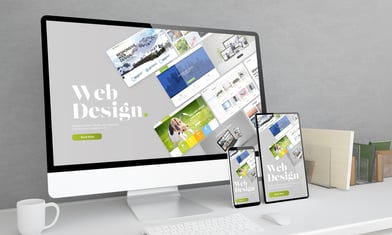Don't have time to read this article? Watch it instead!
Squarespace and Wix and Weebly, oh my! These simple website building tools offer easy drag-and-drop interfaces and can be great for startups, budding small businesses, or getting a side job off the ground. But DIY web building comes at a cost to your brand. We will dive into why, and point out another way for a business to create a website (even one on a budget).
Why DIY Templates are Misleading
A DIY website tool's templates are well designed. No doubt about that. But when businesses decide to take the "off-the-shelf" template approach and plug their content in, they're usually surprised. What they had envisioned ends up looking nothing like the beautiful website design they thought they had selected. Why?
- Many businesses don’t have a true handle on their brand identity. They are unsure of how to apply a consistent look, feeling, messaging, unique selling proposition, etc. in a way that connects to their audience.
- Website templates are displaying fake content specifically optimized to that template.
- Templates have amazing photography, often with fashionable models and high-end product shots (something many businesses do not have).
- The main goal of the template is to be selected or purchased, not to solve your nuanced and specific business challenges.
- Even though many DIY website building tools are made for “anyone,” a deeper understanding of the web is usually required to really make the template look its best.
- Templates don’t come with discovery meetings to understand your business, plan a content strategy, develop a thoughtful user experience based on your business goals, and make sure your website elevates your brand.
That last bullet point is the most important. Your brand is not the round peg that can fit in the square hole. It is complex, it has a personality, it needs to live online and look its best, and it needs to be authentically you.
You Get What You Pay for
Using a pre-made template to build your website and hiring a professional to build a website both score you a website, right? Yes. In the same way, a McDouble and a filet mignon are both meat. A professionally built website will take more time, effort, involvement, and resources. But it will also get more leads and convert them to customers quickly, which pays back your investment. A templated DIY website tool is directionless more often than not. You really have to know what you are doing to make it work the way you want.
Don't Stuff Your Brand into a Template: Build Your Website to Fit Your Brand Instead
 Your brand can live on many platforms, such as Instagram, Facebook, and LinkedIn. But you do not completely own your content on those platforms. It is being “rented.” Your content is like a tenant who is renting space from a landlord (a social platform).
Your brand can live on many platforms, such as Instagram, Facebook, and LinkedIn. But you do not completely own your content on those platforms. It is being “rented.” Your content is like a tenant who is renting space from a landlord (a social platform).
A custom, professionally built website allows you to control your own little corner of the internet. Your business has (or should have) a unique voice, look, attitude, story, needs, strategies, goals, etc. Templates assume all of this… and you know what they say about assuming. Your website can be the most powerful way to curate all of your uniqueness in one place. When you hire a pro to build your web pages, brand comes first. Your website is strategized, built, and designed based on your brand, your story, your customers, and how you need the site to perform.
Customer Experience - The 3:30:3 Rule
Messaging and visuals need to work together and the flow of your web pages needs to turn a visitor into a lead or customer. The 3:30:3 rule breaks down how this happens:
3 Seconds
You have three seconds to hook a visitor with a great first impression. The first impression = headline + visuals + a brief descriptor. Text needs to be concise and visuals need to be presented in an appealing way (can't overdo it or have too few, or be poorly presented). Get any of these elements wrong and the visitor might bail and never come back. You never get a second chance to make a first impression.
30 Seconds
If you managed to hook the visitor with a good first impression, you have 30 more seconds to keep them on your website. Upon scrolling, clicking, or tapping, the visitor needs to gain a deeper understanding of what you offer - why your product or service is better and unique. They're also looking to your website to answer their own questions. But this half-minute of education needs to be skimmable. People don't usually read everything on your web page. They will skim, scan, look for cues and context, and they will form quick opinions.
3 Minutes
If you have kept the visitor on your site for more than 30 seconds, they are likely going to dive a little deeper. This is when they will look at more explanatory content, blog posts, videos, etc. In these three minutes, they are looking for social proof, deeper knowledge, and credentials that prove or validate what they learned in the first 30 seconds.
If you nail the 3:30:3 rule, you will probably have a lead, a returning visitor, or maybe even a customer. It is a very narrow window and not worth risking getting it wrong.
The Bottom Line
 Hiring a professional, such as Sharpe Creative, to develop your brand, website, and digital marketing will cost more and take more time and effort than giving it a go on your own. But the value of involving the pros will bring the results and ROI you really need.
Hiring a professional, such as Sharpe Creative, to develop your brand, website, and digital marketing will cost more and take more time and effort than giving it a go on your own. But the value of involving the pros will bring the results and ROI you really need.






Comments